Old Dhaka's ticking TIMEBOMB
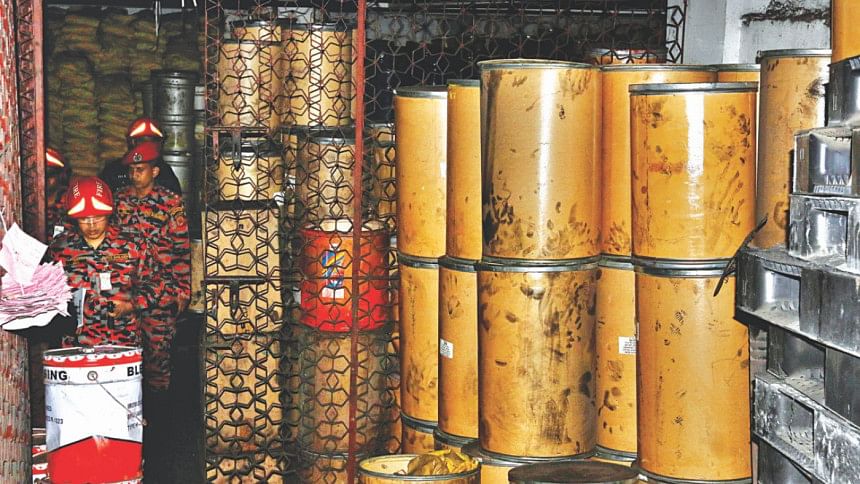
The old town blaze that claimed at least 67 lives could have been even more devastating had the flames came into contact with the huge stockpile of chemicals in the basement of Haji Wahed Mansion.
A team of firefighters yesterday searched the building in Chawkbazar's Churihatta, only to make a terrifying revelation that several hundred barrels and sacks of combustible and flammable substances were stored in the basement.
Major AKM Shakil Newaz, director (operations and maintenance) of fire service, said they found 16 types of chemicals at the basement of the building, the centre of Wednesday night's inferno.
According to an expert, at least four of those posed extreme risk and the casualty would have been higher if the flames had reached those.
“The fire would have gone beyond our control had the chemicals caught fire. It would have continued until the chemicals were burnt away,” Ratan Kumar Debnath, station officer of Lalbagh Fire Service Station, said after visiting the basement.
The finding contradicts the claim of Industries Minister Nurul Majid Mahmud Humayun, who said on Thursday, “There was a warehouse of perfumes and cosmetics [in the worst affected building] but no chemicals…”
Wahed Mansion had been standing on a ticking timebomb like many other buildings in Old Dhaka. They store flammable substances enough to cause disaster similar to Chawkbazar and Nimtoli.
According to a survey by the Fire Service and Civil Defence at the end of 2017, a total of 360 factories and stores of chemicals were found in the areas under ward 24 and 35 of Dhaka South City Corporation. Both the wards fall under Old Dhaka.
It means the number of such factories and stores in entire old town would be much higher.
Most chemical warehouses and stores are located in Mitford, Armanitola, Kayettuli, Agamasi Lane, Islambagh, Bangshal, Shaheednagar, Chawkbazar, Imamganj and Babubazar areas, locals said.
A top official of Dhaka Metropolitan Police, after a visit to the site of the fire on Thursday, unofficially said there are around 500 such factories and warehouses in the old town.
Many locals, however, believe the figure is much higher.
According to Bangladesh Environment Conservation Rules 1997, no industry can operate in and around a residential area using hazardous chemicals or goods.
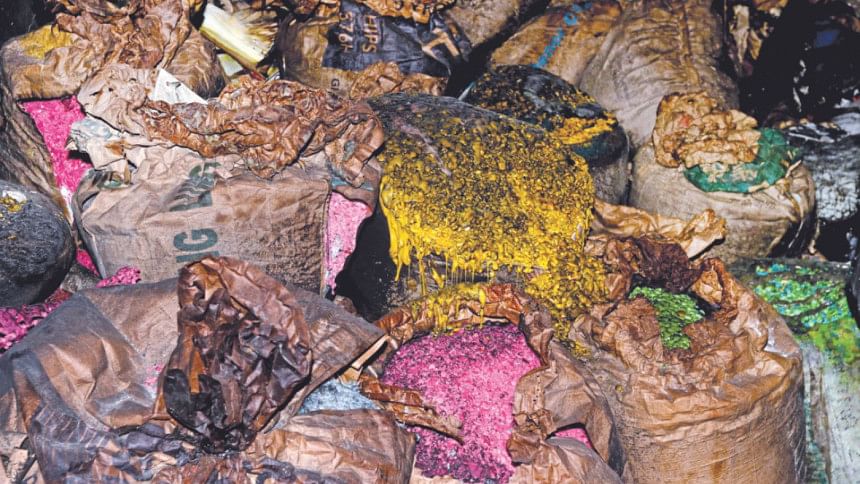
A good number of traders and even some locals, despite knowing all the risks, have always tried in every way to prevent the factories or warehouses from being removed for their business interest, sometimes managing the authorities.
There were even incidents of attacks on journalists who visited the area to report on the hoarding of chemicals.
A HOUSE OR A WAREHOUSE?
A team of firefighters led by Ratan Kumar entered the basement after breaking the locks and found several hundred barrels and sacks containing the substances.
Ratan said they entered the building as a part of their search to find out whether there is anyone. “But, we found a huge warehouse of dye materials and chemicals,” he said.
The Daily Star has learnt names of 12 of the 16 substances and sent the list to Prof Abu Bin Hasan Susan, a professor of the department of chemistry at Dhaka University.
He said eight out of those are either combustible or flammable. “These are all chemicals -- mainly dye,” he added.
mong those, four chemicals -- Oil Orange, Metal Powder, Pigment T Red and Silver White -- are highly flammable or combustible, according to the professor.
He did not comment on two substances.
When a correspondent of The Daily Star visited the building, the blue gate led him to the dark basement. He found no ventilator or window but a single entrance with hundreds of chemical drums and sacks stored there.
Ratan Kumar said the owner set up the warehouse without following any rules or regulation. “Had the fire spread to the basement, smoke would have come out through the single entrance making it impossible for us to enter.”
CHEMICALS STORED ON OTHER FLOORS
Abdul Wahed, a former commissioner of ward-64 of undivided Dhaka City Corporation, constructed the building 18 to 20 years ago, locals said.
Of his two sons, Hasan lives on the third floor of the four-storey building with his family. Two other tenants live on the floor, which also accommodates a storeroom of perfume and lotion.
Wahed's other son Sohel's family lives on the second floor.
Hasan was in Chattogram during the fire while his family members could come out safely, his driver Monir Hossain said.
The first floor of the building houses two storerooms -- one for perfume cans and another for electric equipment. The second floor houses a storeroom of perfumes along with three residential flats.
Tofazzal Hossain, tenant on the second floor, said he complained to Hasan about water crisis a month ago.
“But, instead of solving it, he asked me to leave the flat saying he would get more money if he rent it out to a businessman as a warehouse,” Tofazzal said.
Lt Col SM Julfiqur Rahman, a director of fire service, who is a member of the probe body formed by the DSCC, yesterday said, “Cans of deodorants and lighter refilling fuel were stored inside the building. These are flammable chemicals.”
Since early morning yesterday, conservancy workers of city corporation were seen cleaning the site and adjacent roads.
Hundreds of people from nearby areas crowd the scene of the second deadliest chemical-fuelled fire in the country after the 2010 Nimtoli tragedy.
Police were struggling to ward off the crowed from entering the scene. They barricaded all the five entrances.
As of yesterday, the Dhaka district administration handed over 46 bodies of fire victims to their relatives.
[Shariful Islam, Tuhin Shubhra Adhikary, Rafiul Islam, Muntakim Saad and Moudud Sujan prepared the report]

 For all latest news, follow The Daily Star's Google News channel.
For all latest news, follow The Daily Star's Google News channel. 


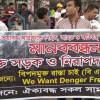
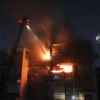

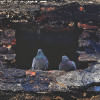


Comments